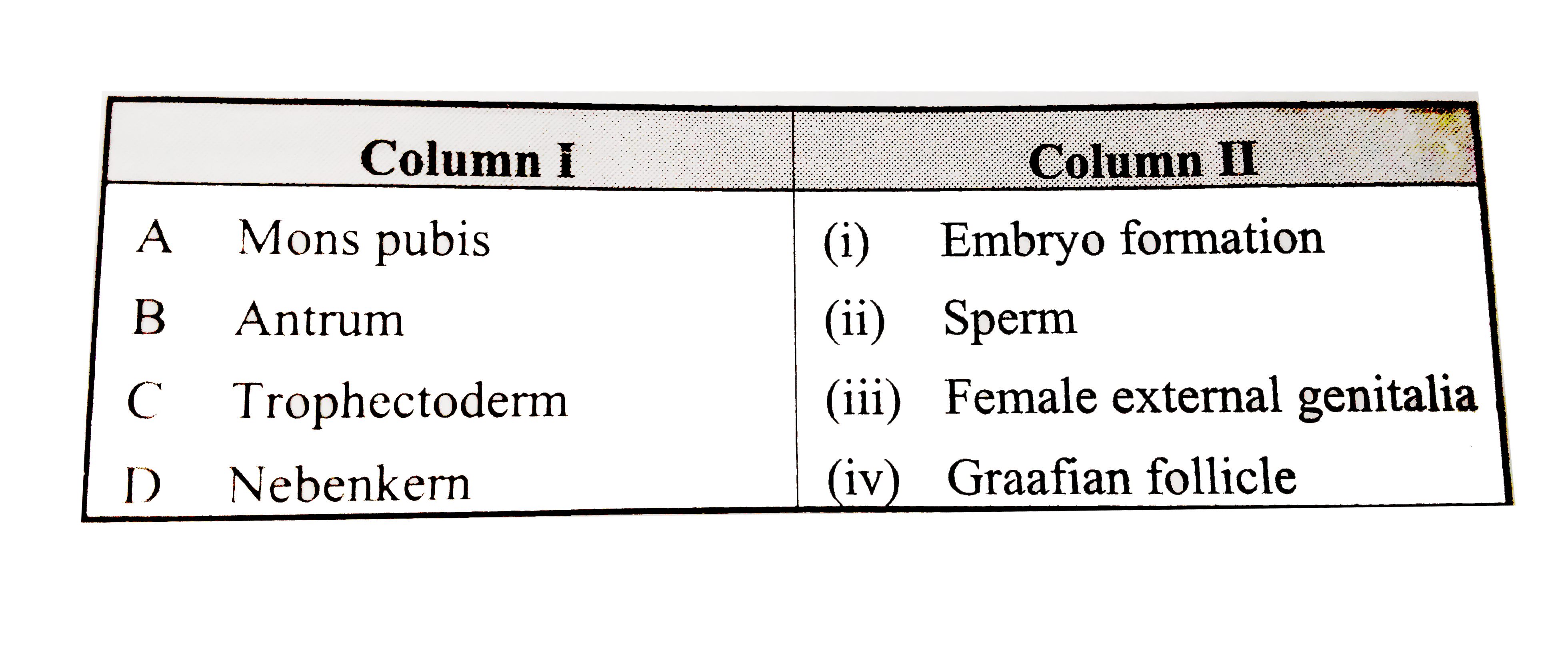Match columnI with column II and select the correct option from the codes given below.

A−(iv),B−(iii),C−(v),D−(ii),E−(i)
A−(i),B−(iii),C−(iv),D−(ii),E−(v)
A−(iv),B−(iii),C−(i),D−(ii),E−(v)
A−(v),B−(iv),C−(iii),D−(ii),E−(i)
The correct Answer is:C
Step by step video, text & image solution for Match columnI with column II and select the correct option from the codes given below. by Biology experts to help you in doubts & scoring excellent marks in Class 11 exams.
Updated on:21/07/2023Topper's Solved these Questions
- TRANSPORT IN PLANTSBOOK - NCERT FINGERTPS ENGLISHCHAPTER - TRANSPORT IN PLANTSEXERCISE - Uptake and Transport of Mineral Nutrients
3 Videos
- TRANSPORT IN PLANTSBOOK - NCERT FINGERTPS ENGLISHCHAPTER - TRANSPORT IN PLANTSEXERCISE - Phloem Transport:Flow From Source To Sink
11 Videos
- TRANSPORT IN PLANTSBOOK - NCERT FINGERTPS ENGLISHCHAPTER - TRANSPORT IN PLANTSEXERCISE - Long Distance Transport of Water
12 Videos
- THE LIVING WORLDBOOK - NCERT FINGERTPS ENGLISHCHAPTER - THE LIVING WORLDEXERCISE - The Living World
130 Videos
Similar Questions
Match the column -I with column-II and select the correct option from the codes given below :
METHODMODE OF ACTIONa WBCiCardiac discb Adipose tissue ii Protects and support neuronsc Communication junctionsiiiDiapedesisd NeurogliaivStore fats
View SolutionMatch column I with column II and select the correct option using the codes given below:

View Solution
Knowledge Check
Match the column I with column II and select the correct option from the codes given below.
Column IColumn IIFrancesco Redi(i)Theory of chemical evolution of lifeL.Pasteur(ii)Disproval of spontaneous generationRichter(iii)Swan necked flask experimentOparin(iv)Mutation(v)PanspermiaAv,i,iv,iiBii,iii,v,iCv,iv,ii,iDi,ii,iii,iv,Match column I with column II an select the correct option from the codes given below.
Column IColumn IIA. Carbomino-heamoglobin(i) InspirationB. Diaphragm(ii) Hamburger's phenomenonC. Larynx(iii) Diffusion of Cl−into RBC D. Pons varolii(iv) Carbon dioxideE. Chloride shift(v) Cartilages(vi) Pneumotaxic centre(vii) ExpirationAA−(iv),B−(i),(vii),C−(v),D−(vi),E−(ii),(iii)BA−(v),B−(i),C−(iv),(vii),D−(vi),E−(ii),(iii)CA−(ii),(vi),B−(i),C−(iii),D−(v),(vii),E−(iv)DA−(iii),B−(i),C−(ii),(v),D−(vi),(vii),E−(iv)Match column I with column II and select the correct option from the code given below.
Column IColumn IIA.Pseudostratifiedepithelium(i)Connective tissueB.Matrix(ii)AbsorptionC.Striated myofibril(iii)TracheaD.Mesothelium(iv)Body cavity liningE.Microvilli(v)MultinucleateAA-(i),B-(ii),C-(iii),D-(iv),E-(v)BA-(ii),B-(v),C-(iv),D-(i),E-(iii)CA-(iii),B-(i),C-(v),D-(iv),E-(ii)DA-(iv),B-(iii),C-(v),D-(i),E-(ii)
Match column I with column II and select the correct option from codes given below.
Column IColumn IIAllergy(i)Activation of B-cellsHelper T-cells(ii)ImmunotherapyAIDS virus(iii)CarcinogensX-rays(iv)IgETreatment of cancer(v)Single stranded RNA
View SolutionMatch Column I with Column II and select correct option from the codes given below.

View SolutionMatch column I wth column II and select the correct option from the codes given below
Column IColumn IIA. Sagopalm(i). EphedraB. Chilgoza fruit(ii). Pinus gerardianaC. Ephedrine drug(iii). cycas revoluteD. Cedar wood oil(iv). Juniperus Virginiana
View SolutionMatch column I with column II and select the correct option from codes given below.
Column IColumn IILeishmania donovani (i)MalariaWuchereria bancrofti(ii)AmoebiasisTrypanosoma gambiense(iii)Kala azarEntamoeba histolytica(iv)Sleeping sickness (v)Filariasis
View SolutionMatch column I with column II and select the correct option from codes given below.
Column IColumn IISporozoites (i)Infectious form of PlasmodiumFilariasis(ii)Aedes mosquitoesTyphoid(iii)WuchereriaChikungunya(iv)Widal test
View Solution
